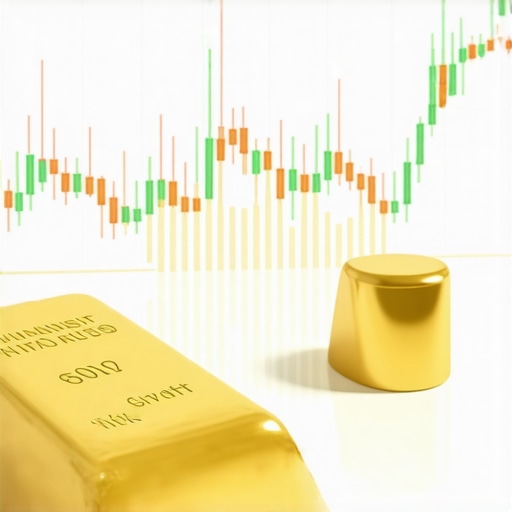Understanding the Gold IRA: A Secure Investment Option
As a new investor looking to diversify your portfolio, you may have heard about the advantages of a Gold IRA. A Gold IRA, or Individual Retirement Account, allows you to hold physical gold and other precious metals as part of your retirement savings. This investment strategy is gaining traction among investors who seek a hedge against inflation and economic uncertainty. In this article, we will explore the key benefits of a Gold IRA and why it could be a smart addition to your investment strategy.
Why Choose a Gold IRA?
One of the main benefits of a Gold IRA is its ability to provide stability during market fluctuations. Unlike traditional stocks and bonds, gold has historically maintained its value, making it an attractive option for those worried about market volatility. This is particularly relevant in today’s economic climate where uncertainties abound.
Moreover, a Gold IRA offers tax advantages that can enhance your retirement savings. Contributions to a Gold IRA can be made with pre-tax dollars, allowing your investments to grow tax-deferred until you withdraw them in retirement. This can significantly increase your overall returns, especially when compared to taxable investment accounts.
Protecting Against Economic Downturns
Gold has long been viewed as a safe haven asset, especially during economic downturns. When fiat currencies depreciate, gold often appreciates, making it a valuable asset to hold. For new investors, understanding how gold can act as a hedge against economic uncertainty is crucial. Investing in a Gold IRA can provide peace of mind knowing your retirement savings are safeguarded against potential financial crises.
Additionally, diversifying your retirement portfolio with a Gold IRA can mitigate risks associated with inflation. As the cost of living rises, the purchasing power of cash can diminish. Gold, however, tends to increase in value over time, helping to preserve your purchasing power in retirement.
The Flexibility of Gold IRA Investments
Gold IRAs are not limited to just gold bullion; they can also include a variety of precious metals such as silver, platinum, and palladium. This flexibility allows investors to choose a combination of assets that best suits their financial goals and risk tolerance. For more insights on diversifying your portfolio, check out our guide on Gold Stocks and Mutual Funds: Diversifying Your Portfolio.
Another appealing aspect of Gold IRAs is the option to invest in gold coins. Coins often carry a collectible value that can enhance their worth beyond just the market price of gold. However, it’s essential to do thorough research and consult with financial advisors to ensure you are making informed decisions.
Conclusion
In conclusion, a Gold IRA presents numerous benefits for new investors looking to secure their retirement. From providing stability during economic uncertainty to offering tax advantages and investment flexibility, incorporating gold into your retirement strategy can be a wise choice. For a more comprehensive understanding of gold investments, don’t miss our Comprehensive Guide to Buying Gold. By taking the time to educate yourself on the advantages of a Gold IRA, you can position yourself for a more secure financial future.
Investing in Gold IRA: Key Benefits You Should Know
When considering a Gold IRA as part of your retirement strategy, it’s essential to understand the various benefits it offers. One of the most significant advantages is asset protection. Gold and other precious metals can act as a buffer against market crashes, preserving your wealth when traditional investments falter. For instance, during economic downturns, gold often shows resilience, making it a more stable investment compared to stocks or bonds. This protective quality is crucial for individuals looking to secure their retirement savings.
Tax Advantages of a Gold IRA
Another compelling reason to explore Gold IRA options is the tax benefits associated with these accounts. Contributions are typically tax-deductible, and, similar to traditional IRAs, your investments grow tax-deferred. This means you won’t pay taxes on gains until you withdraw funds during retirement, potentially placing you in a lower tax bracket. This can significantly enhance your overall returns, allowing your investment to compound over time.
Diversification: A Key to Successful Investing
Diversifying your retirement portfolio is vital, and a Gold IRA can play a pivotal role in this strategy. By including gold, silver, and other precious metals in your retirement assets, you not only reduce risk but also increase potential returns. As market conditions fluctuate, different asset classes react in various ways, and having a mix can help mitigate losses. For detailed strategies on diversifying with gold, consider reading our article on Gold Stocks and Mutual Funds: Diversifying Your Portfolio.
Understanding Gold Bullion and Coins
In a Gold IRA, investors have the option to hold both gold bullion and coins. Gold bullion refers to physical gold in bars or ingots, while gold coins can include various minted coins that are recognized for their value. Each has its advantages; bullion typically has lower premiums over spot prices, whereas coins may have additional collectible value. It is essential for new investors to research these options and consult financial advisors to determine which best suits their investment goals.
How to Choose the Right Gold for Your IRA
When selecting gold for your IRA, consider factors such as purity, type, and market demand. The IRS has specific regulations regarding the types of gold that can be held in IRAs, typically requiring a minimum purity of 99.5%. Investing in well-known bullion coins like the American Eagle or Canadian Maple Leaf can be a safe choice. For a comprehensive view on this topic, check out our guide on Understanding Gold Bullion: An Investment Primer.
Long-Term Growth Potential of Gold Investments
Investing in gold through a Gold IRA is not just about protection against economic downturns; it also presents substantial long-term growth potential. Historical data shows that gold prices tend to appreciate over time, often outpacing inflation. This characteristic makes gold an appealing option for retirement portfolios, ensuring that your savings retain their value. To understand the factors influencing gold prices and how they can affect your investments, read our article on How Economic Changes Affect Gold Prices Today.
Conclusion
The journey of investing in a Gold IRA can be an enriching experience that offers numerous advantages, from tax benefits to portfolio diversification and long-term growth potential. By understanding the various aspects of Gold IRAs, you can make informed decisions that align with your retirement goals. For an in-depth exploration of all your gold investment options, be sure to check out our Comprehensive Guide to Buying Gold. This knowledge will empower you to navigate the complexities of gold investments and help secure your financial future.
Understanding Gold ETFs and Their Benefits
Gold Exchange-Traded Funds (ETFs) have become a popular investment avenue for those looking to gain exposure to gold without the hassles of physical ownership. These funds are designed to track the price of gold and can be traded like stocks on major exchanges. One of the primary benefits of investing in gold ETFs is their liquidity; you can buy and sell shares quickly, providing flexibility that physical gold does not offer.
Cost-Effective Investment in Gold
Another significant advantage of gold ETFs is the cost efficiency associated with them. Unlike physical gold, which incurs storage and insurance costs, gold ETFs typically have lower management fees. This makes them an attractive option for investors looking to minimize expenses while maximizing exposure to gold. If you want to explore the cost-benefit analysis more deeply, check out our post on Analyzing Gold Mutual Funds: Costs vs. Benefits.
Diversifying Your Portfolio with Gold ETFs
Integrating gold ETFs into your investment strategy can enhance diversification. Given gold’s historical performance as a safe haven during economic uncertainties, including it in your portfolio can stabilize returns. This is especially beneficial during stock market downturns, as gold often moves inversely to stocks. For further insights into diversification strategies, refer to our article on Gold Stocks and Mutual Funds: Diversifying Your Portfolio.
How to Choose the Right Gold ETF
When selecting a gold ETF, consider factors such as the fund’s expense ratio, the underlying assets, and the performance history. Some ETFs are backed by physical gold, while others may invest in gold mining stocks, which can introduce additional risks. Researching these aspects will help you make informed decisions that align with your investment goals. For a comprehensive overview of various options, visit our guide on How to Choose the Best Gold ETFs for Your Portfolio.
Gold ETFs vs. Physical Gold: Making the Right Choice
Investors often grapple with the decision of whether to invest in gold ETFs or physical gold. While physical gold offers tangible security, it comes with challenges such as liquidity and storage. On the other hand, gold ETFs offer ease of trading and lower costs but lack the physical presence of gold. Understanding your investment goals and risk tolerance will guide you in making the right choice. For more on this topic, read our post on Gold Bullion vs. Gold Coins: Which is the Better Investment?.
Monitoring Your Gold ETF Investment
Once you’ve invested in gold ETFs, regular monitoring is essential. Keeping an eye on market conditions, geopolitical events, and economic indicators can provide insights into potential fluctuations in gold prices. This proactive approach will help you make timely decisions regarding your investments. For a deeper understanding of the factors affecting gold prices, check out our article on How Gold Prices Fluctuate: Key Influencers to Watch.
Long-Term Growth Potential of Gold ETFs
Gold ETFs can serve as a long-term growth investment as they often appreciate in value over time. Historical data indicates that gold has consistently outperformed many traditional asset classes, especially during periods of inflation or economic instability. By incorporating gold ETFs into your retirement strategy, you can bolster your financial security and potential returns. For future insights into gold price trends, be sure to read our post on Gold Price Forecast 2025: Insights You Can’t Miss.
Investing in Gold ETFs: Tips for 2025
As we look towards 2025, maximizing returns from Gold Exchange-Traded Funds (ETFs) requires strategic planning and market understanding. Investors should consider current economic indicators, geopolitical events, and trends in the gold market. For instance, rising inflation rates can often lead to increased gold prices, making now an excellent time to evaluate your investment strategies. Understanding these dynamics is essential to navigate the complexities of gold investments. For a detailed understanding of market forces, check out our guide on How Economic Changes Affect Gold Prices Today.
Understanding Market Trends
Keeping an eye on market trends is crucial for any investor. Analyzing data and anticipating fluctuations in gold prices can help you make informed decisions. For example, if you notice a trend towards increased demand for gold during economic uncertainty, it may be wise to increase your holdings in gold ETFs. To better understand these trends, refer to our insightful article on Current Trends in Gold Price Forecasts: What We Know.
Utilizing Technical Analysis for Gold ETFs
Technical analysis can provide valuable insights into the timing of your gold ETF investments. By examining historical price movements and patterns, you can identify potential entry and exit points. Tools such as moving averages, Relative Strength Index (RSI), and Bollinger Bands can assist you in making data-driven decisions. For more on technical analysis fundamentals, visit our guide on How to Analyze the Gold Market Before Investing.
Setting Investment Goals
Establishing clear investment goals is vital for long-term success with gold ETFs. Decide whether you are looking for short-term gains or long-term wealth preservation. This decision will influence your choice of ETFs, whether you prefer those that track gold prices directly or those that invest in gold-related stocks. For guidance on setting and achieving your investment goals, see our article on Your Guide to Understanding Gold as an Investment.
Evaluating Costs and Returns
When investing in gold ETFs, evaluating costs is crucial. Management fees, trading commissions, and potential tax implications can impact your overall returns. Conducting a cost-benefit analysis can help you identify the most efficient ETFs that align with your investment strategy. For detailed insights on evaluating costs, check our post on Analyzing Gold Mutual Funds: Costs vs. Benefits.
Balancing Risk and Reward
A successful investment strategy involves balancing risk and reward. Gold ETFs can be volatile, influenced by various factors such as currency fluctuations and global economic conditions. Diversifying your portfolio with other asset classes can mitigate this risk. For more on diversification strategies, read our article on Gold Stocks and Mutual Funds: Diversifying Your Portfolio.
Conclusion: Embracing Gold ETFs for 2025
As we look ahead to 2025, gold ETFs present an attractive investment opportunity for those seeking to enhance their portfolio’s stability and growth potential. By understanding market trends, utilizing technical analysis, setting clear investment goals, and critically evaluating costs, you can maximize your returns on gold ETFs. Remember, investing in gold is not just about chasing profits; it’s about building a resilient portfolio that can withstand economic uncertainties. For a comprehensive guide on gold investing, visit Gold Investment: A Comprehensive Guide to Buying Gold.
Frequently Asked Questions about Gold ETFs
What are Gold ETFs and how do they work?
Gold Exchange-Traded Funds (ETFs) are investment funds that track the price of gold and trade on stock exchanges. They provide investors with exposure to gold without the need to physically own it. Gold ETFs typically hold gold bars in vaults and issue shares that represent a fractional ownership of the gold held.
Why should I invest in Gold ETFs?
Investing in gold ETFs offers a convenient way to gain exposure to gold prices with lower fees compared to traditional gold investments. They are easily tradable on stock exchanges, providing liquidity and flexibility. Additionally, gold often acts as a hedge against inflation and economic uncertainty, making it a valuable asset in a diversified portfolio.
How do Gold ETFs compare to physical gold?
While both gold ETFs and physical gold serve as investments in gold, they differ significantly. Gold ETFs provide liquidity, ease of trading, and no storage concerns, whereas physical gold requires secure storage and insurance. Additionally, gold ETFs may have management fees, while physical gold does not, but it can incur costs related to storage and insurance.
What are the risks associated with Gold ETFs?
Gold ETFs can experience price volatility based on market demand, geopolitical events, and economic conditions. Investors should also consider management fees, potential tracking errors, and the impact of currency fluctuations on returns. It’s essential to evaluate these risks and align them with your investment strategy.
How do I choose the best Gold ETF for my portfolio?
When selecting a gold ETF, consider factors such as management fees, liquidity, historical performance, and the fund’s structure (physical gold vs. futures contracts). Research the fund’s expense ratio and compare it with similar ETFs to ensure you select the most cost-effective option. For more detailed insights, check our resources on how to select the best gold ETF.
Can I invest in Gold ETFs through a retirement account?
Yes, many retirement accounts, such as IRAs, allow you to invest in gold ETFs. This can be a strategic way to diversify your retirement portfolio while benefiting from potential tax advantages. Be sure to check the specific rules and regulations of your retirement account provider regarding gold investments.
What is the tax treatment of Gold ETFs?
In many jurisdictions, gold ETFs are treated as collectibles, which can lead to higher capital gains tax rates compared to stocks or bonds. It’s vital to consult with a tax advisor to understand the implications of investing in gold ETFs and how to optimize your tax strategy.
How do currency fluctuations affect Gold ETF investments?
Currency fluctuations can impact the returns on gold ETFs significantly, especially for investors holding ETFs in currencies other than the US dollar. When the dollar weakens, gold prices often rise, benefiting dollar-denominated gold investments. Conversely, a stronger dollar can lead to lower gold prices. Understanding this relationship is crucial for managing your investments effectively.
What are the current trends in Gold ETF investments?
Current trends suggest that gold ETFs are gaining popularity as investors seek safe-haven assets amid economic volatility. Increased demand for gold for both investment and industrial purposes is driving prices, and many analysts predict a continued upward trajectory for gold ETFs as market uncertainties persist. For an in-depth analysis, refer to our current trends article.
Conclusion: Embracing Gold ETFs for Your Investment Strategy
As we approach 2025, investing in Gold ETFs presents a compelling opportunity for both novice and seasoned investors. By understanding market trends, employing technical analysis, setting clear investment goals, and evaluating costs effectively, you can enhance your investment strategy. Gold ETFs not only serve as a hedge against economic uncertainties but also contribute to a diversified portfolio. For a comprehensive exploration of gold investing strategies, check our main resources and guides.










